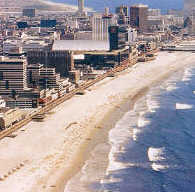SJ Towns: Atlantic City
 When you think of Atlantic City, you automatically think of Casinos and neon lights right? How many of you remember Atlantic City before 1977, before the casinos lined the boardwalk and cast long shadows across the beach?
When you think of Atlantic City, you automatically think of Casinos and neon lights right? How many of you remember Atlantic City before 1977, before the casinos lined the boardwalk and cast long shadows across the beach? Let’s step back a bit a see who and what made this town what it is today and what it will be in the future.
Long before the first bet was placed or a jackpot won, the town was a resort town. Well sort of anyway. You see the Leni-Lenape Indians used to make modern day Atlantic City their summer getaway. They would travel from the mainland across the marshes to enjoy all the benefits of the beach and sea.
In the late 1670s the area saw it’s first registered land owner. An Englishman by the name of Thomas Budd was given the some land as part of a settlement in a claim he had against the holders of the Royal Grant. Valued today at millions of dollars Budd’s land was valued at $0 .40 an acre for the mainland property and a mere $0.04 per acre for his “beach front” property.
Another 100 years or so passed before Atlantic City saw it’s first “Official resident”. Jeremiah Leeds and his family took up residence at what is now known as the intersection of Arctic and Arkansas Aves. In 1838, about a year after Jeremiah’s death, Millicent Leeds obtained a license to operate and tavern, and thus Atlantic City’s first “Official Business” was born. The Leeds family continued to play an important roll in the development of Atlantic City with one son, Robert going on to become the City’s first Postmaster, and another son, Chalkey becoming the city’s first Mayor in 1854.
Another contributor to the growth of Atlantic City was a physician by the name of Jonathan Pitney. Pitney felt that the area would make a great health resort, but that access to the area needed to improve. Pitney and a civil engineer named Richard Osborne cooked up the idea to bring the railroad to Atlantic City, and in 1852 construction started. A short two years later, on July 5th, 1854 the first train pulled into Atlantic City after a 2.5 trip from Camden, and Atlantic City was changed forever.
Throughout the remainder of the 1800s Atlantic City continued to grow by leaps and bounds. A second rail line was added, grand hotels lined the streets and life was good. Good, except for one thing… the sand. It was everywhere. In the hotels, the restaurants, the streets. As a solution to this the first Boardwalk was built. Today the famous A.C. Boardwalk is 60 feet wide and stretches for 6 miles.
The 1900s saw the arrival of amusement piers. The Steel Pier, Million Dollar Pier and Iron Pier were all major attractions for the area. 1940 brought the Miss America Pageant to Convention Hall, and Atlantic City was the “Place to be”.
The end of World War two brought with it what many thought would be the end of Atlantic City. Commercial air travel and the move westward drew people from A.C. and she went into a slump, and began a slow painful death.
In 1976, with the passage of the Casino Gambling Referendum, Atlantic City once again began to grow. Now with a dozen casinos, a new convention center, bus terminal, baseball stadium, Hockey team and many other great attractions Atlantic City is once again becoming the world’s favorite playground.
Names like Budd and Leeds may have been replaced with Trump, Showboat and Hilton, but Atlantic City is still the same great city she was over 100 years ago. So whether you go to win a million dollars or just to visit Lucy the elephant, you’ll be sure to have a great time in this city.
Now the next time you play Monopoly you can entertain your friends with your knowledge of Atlantic City.
Some important dates for Atlantic City:
advertisement

Author: Steve Kelly - Editor, SouthJersey.com
Archives
Advertise with SouthJersey.com
Shawnee High School
Attractions: N. Pemberton RR Station
New and Improved
Color Me Happy
Collingswood High School
Don't Miss Your Chance to Enter
Kick Off Summer with Unlocking of Ocean
Prof Tells How to Communicate With Kids
And Then There Were Two
New Certificate Prog. at Rutgers-Camden
The Blue Comet Rides Again
R-C Selected as NJ The Big Read Site
Cleopatra Lecture Series at CCC
Surflight Theatre Earns Innovator Award
More...







